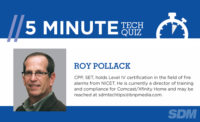Test your Life Safety System Testing knowledge with the following quiz.
All answers may be found in NFPA 4.
1. What is the Standard for Integrated Fire Protection and Life Safety System Testing?
A. UL 1023
B. UL 685
C. NFPA 3
D. NFPA 4
E. NFPA 5
Feedback:
2. An asterisk (*) following the number or letter designating a paragraph indicates _____________.
A. new material has been extracted from the document
B. words within that section were deleted
C. annexes, sections, figures or tables are new
D. that explanatory material on the paragraph can be found in the annex
Feedback:
3. A triangle to the left of a table or figure number indicates _____________.
A. new material has been extracted from the document
B. words within that section were deleted
C. there was a revision to an existing table or figure
D. annexes, sections, figures or tables are new
E. explanatory material on the paragraph can be found in the annex
4. A triangle before a section indicates ______________.
A. new material has been extracted from the document
B. words within that section were deleted
C. there was a revision to an existing table or figure
D. annexes, sections, figures or tables are new
E. explanatory material on the paragraph can be found in the annex
Feedback: 386.2
5. The scope of NFPA 4 states that the standard ____________________.
A. shall provide the minimum requirements for testing of integrated fire protection and life safety systems
B. outlines the minimum requirements for testing of integrated fire protection and life safety systems
C. the shall provide the minimum requirements for testing of integrated fire protection systems
D. shall provide the minimum requirements for testing of integrated fire protection and life safety systems as well as all individual systems that are operational within a facility
6. Look at the ‘What’s Wrong With This?’ photo below. Is the installation in accordance with the NEC?
A. passive and active integrated fire protection and life safety systems
B. integrated passive and active fire protection and life safety equipment and systems
C. only to active integrated fire protection and life safety equipment and systems
D. integrated passive and active fire protection and life safety systems
E. integrated passive and active fire protection and life safety systems and other related equipment
Feedback:
7. An integrated testing agent (ITa) shall have _______________ integrated operations of the design, installation, operation and maintenance of the type of fire protection and life safety systems installed.
A. the skills that demonstrate an experience or knowledge of
B. been certified by NICET as knowledgeable with
C. the been approved by the AHJ as knowledgeable in
D. All of the above
E. None of the above
8. An integrated testing agent (ITa) shall be identified by________, who plans, schedules, document coordinates, and implements the integrated testing of the fire protection and life safety systems and their associated subsystems.
A. NICET
B. UL
C. the AHJ
D. the owner
E. any of the above
Feedback:
9. An initial integrated systems test shall verify the intended operation of all integrated systems and functions in accordance with ____________.
A. the commissioning plan
B. integrated system test plan
C. Chapter 14 of NFPA 72
D. All of the above
E. A & B above
F. A & C above
10. The most current edition of the Standard for Integrated Fire Protection and Life Safety System Testing is _____________.
A. 2016
B. 2017
C. 2018
D. 2019
Feedback: 2018
Bonus Questions
- The Standard for Integrated Fire Protection and Life Safety System Testing was first introduced when?
- When NFPA 3 was first introduced, it was not considered a standard. What was it?
Click here to see the answer.
The concept for NFPA 4 first appeared in a Chapter 7 of NFPA 3, 2012 edition. Both the 2012 and 2015 editions of NFPA 3 were recommended practices. The technical committee decided that the idea of commissioning and testing be broken out into two separate documents. NFPA 4 was then created by removing Chapter 7 of NFPA 3 in 2015.


